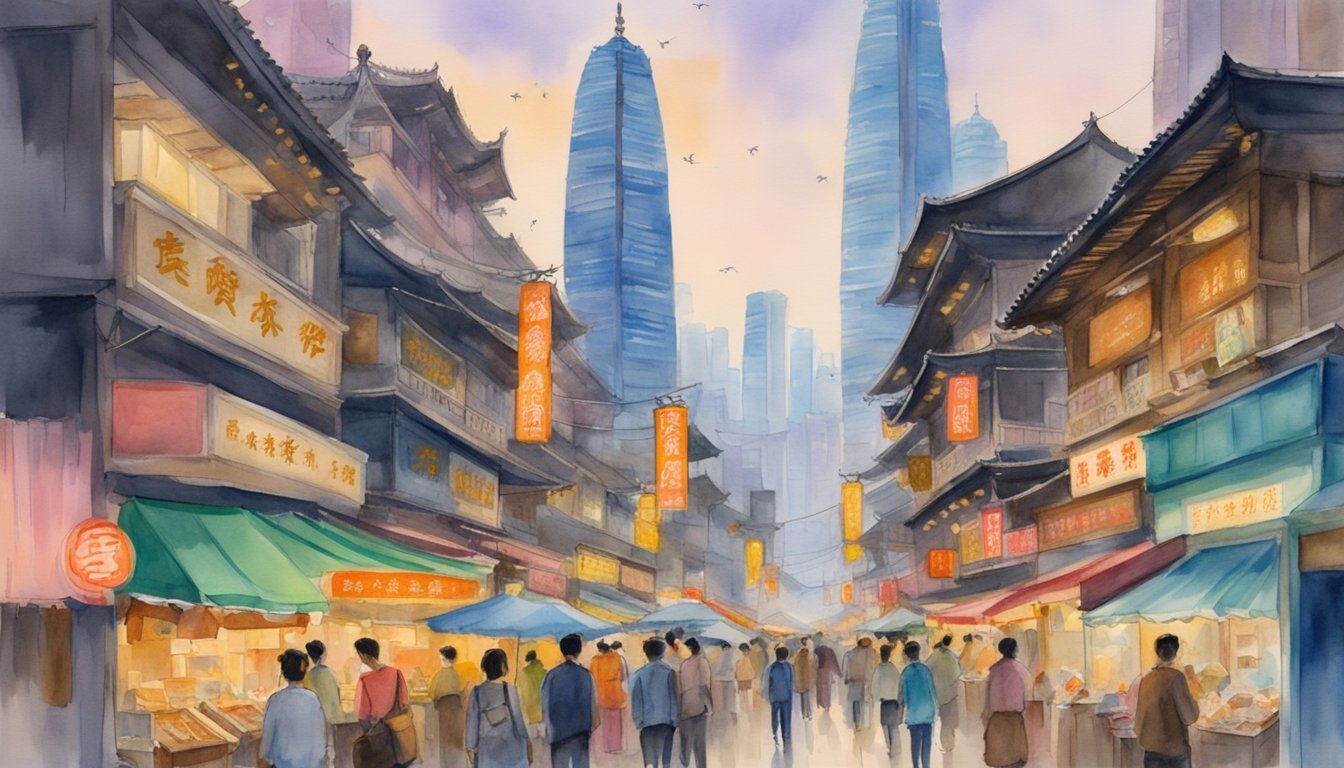History and Culture of Kowloon
Kowloon History from Song Dynasty to Modern Days
Kowloon’s history can be traced back to the Song Dynasty (960-1279), when the area served as a site for salt production. It later developed into a military outpost by the Qing Government in the mid-1800s after Hong Kong Island was ceded to Britain in 1842. The Kowloon Walled City’s origins date back to the 1660s when it was home to a minor military fort. The fort stayed small for centuries, but its significance grew after the New Territories were leased to the United Kingdom in 1898 (source).
During World War II, the Japanese occupied Hong Kong from 1941 to 1945. After the war, chaos led to an influx of Chinese refugees into Kowloon, causing a population boom. The area experienced rapid urbanization and became synonymous with overcrowded, ungoverned regions, such as the infamous Kowloon Walled City.
Cultural Highlights and Temples
Kowloon is known for its culturally rich and diverse neighborhoods, which are home to various religious landmarks. Some of its most famous temples include the Wong Tai Sin Temple, a popular Taoist temple dedicated to the god of healing, and the Tin Hau Temple, built in honor of the goddess of the sea. The Temple Street Night Market is another popular destination, offering a blend of food, shopping, and culture (source).
Evolution of Architecture and Urban Spaces
Kowloon has a distinct architectural charm that reflects its dynamic history and evolving urban landscape. The now-demolished Kowloon Walled City was once home to one of the densest populations in Asia, with tightly packed buildings, balconies, alleyways, and bridges. In contrast, modern Kowloon is known for its skyscrapers and urban parks, such as the Kowloon Park, located in the heart of Tsim Sha Tsui.
Near the waterfront, you can find the Avenue of Stars, a promenade celebrating Hong Kong’s film industry, which offers stunning views of Hong Kong Island’s skyline.
Preservation and Transformation
The Chinese government and the historic preservation movement played significant roles in the redevelopment of Kowloon. The Kowloon Walled City was demolished in the 1990s, and the area was transformed into the Kowloon Walled City Park. The park now serves as a reminder of the area’s vibrant past and stands as an example of adaptive reuse and heritage preservation (source).
Nowadays, Kowloon continues to evolve and adapt, maintaining its unique blend of history, culture, and modernity in the face of ongoing urban transformation. With new developments reshaping the cityscape, Kowloon remains a vibrant hub where tradition and innovation coexist. The district’s bustling streets and markets reflect its rich heritage, while contemporary influences, such as the excitement surrounding the Miyazaki new movie, add to its dynamic cultural scene. As it moves forward, Kowloon continues to captivate both locals and visitors with its ever-changing yet deeply rooted identity.
Life in Kowloon: Communities and Attractions

Shopping and Markets in Kowloon
Kowloon is a vibrant and bustling shopping destination, with everything from high-end international luxury brands to local street markets. The iconic Hong Kong skyline at Victoria Harbour provides a picturesque backdrop for shopping enthusiasts. In the Central area, you’ll find major shopping centers like Harbour City and Canton Road, offering a variety of shops and restaurants.
For a more local experience, head to areas like Mong Kok and Nathan Road, where you’ll find the Chungking Mansions complex, known for its budget accommodations and diverse range of merchants. The Yau Ma Tei Wholesale Fruit Market is another popular spot, with a lively atmosphere showcasing a variety of fruits and local food. In Sham Shui Po, tech and gadget lovers can visit the Golden Computer Centre and Apliu Street for the latest electronics and accessories at reasonable prices. Fashion enthusiasts can explore Cheung Sha Wan Road, known for its wholesale garment market.
Entertainment and Nightlife
Kowloon has a thriving entertainment scene with bars, karaoke clubs, hotels, and more for those looking to experience Hong Kong’s nightlife. Enjoy a stunning view of the symphony of lights at Victoria Harbour from Aqua Spirit, a popular bar in Tsim Sha Tsui East. At nearby Salisbury Road, you can board the historic Star Ferry for a relaxing harbor cruise.
For a more traditional evening, check out the Temple Street Night Market, where you can find unique souvenirs or enjoy local street food. Just a short walk away lies Ashley Road, a bustling area filled with bars and clubs to cater to all preferences.
Local Lifestyle and Society
Kowloon is home to a diverse population, resulting in a unique blend of cultures. With its high population density, Hong Kong and Kowloon have created vibrant communities where people from all walks of life coexist. Children grow up learning both Mandarin and Cantonese, and can be found practicing in parks and cultural centers like the Cattle Depot Artist Village.
However, Kowloon also has a darker side, with a long history of triads, gambling, prostitution, and other vices. In some areas, unlicensed doctors, dentists, and food stalls operate illegally, catering to the needs of marginalized communities. Despite these challenges, Kowloon remains a fascinating and culturally rich area to explore and experience.

